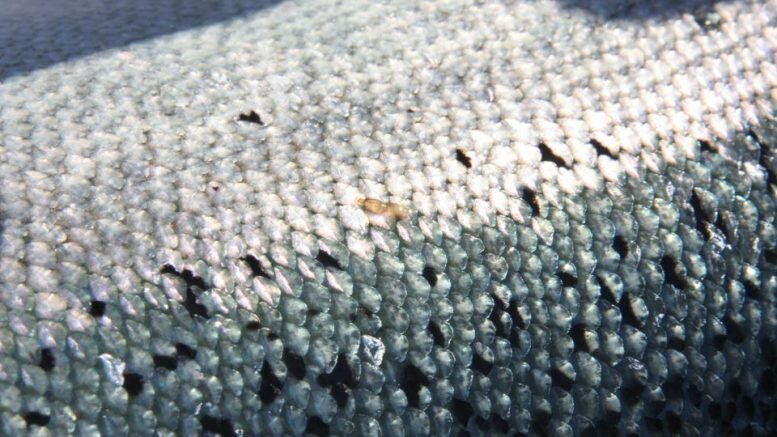Salmon lice can increase their fresh water tolerance and may affect sea trout and arctic char
Use of fresh water against salmon lice on farmed salmon is a widely used method. A new risk assessment shows that the salmon lice through repeated freshwater treatments can increase their fresh water tolerance. This can have consequences for sea trout and char living in the fjords.
“The Norwegian Food Safety Authority has taken an initiative for the Ministry of Food and Fisheries, the Directorate of Fisheries and the Environment Directorate to clarify whether freshwater treatment is still to be allowed in the aquaculture industry or whether this treatment method is to be regulated,” says Elisabeth Wilman, Director of Fish and Seafood in the Norwegian Food Safety Authority (Mattilsynet).
Freshwater treatment against salmon lice and other parasites (AGD) has increased in scope and is common in Norwegian farming. In 2015, the Norwegian Food Safety Authority ordered a assessment of the risk that the salmon lice could develop increased tolerance for fresh water due to the treatments.
Conclusion of the risk assessment The Veterinary Institute and Norway’s Environmental and Biological Sciences University and the University of Bergen / SLRC cooperation can be summarized in two main points:
- The use of fresh water increases the likelihood of salmon lice with altered freshwater tolerance
- Salmon lice will not reproduce in fresh water
“This means there is no reason to worry that the salmon lice can establish and reproduce in Norwegian waters, rivers and lakes,” says Fisheries and Seafood Director Elisabeth Wilmann. However, selection through increased use of freshwater treatment is more likely to change the tolerance of the population, so that more salmon lice will withstand lower salinity for a longer time.
Need for clarification
The Norwegian Food Safety Authority therefore ordered a new assessment of the likelihood of increased tolerance of freshwater for wildlife species. The evaluations carried out by the Institute of Marine Research in collaboration with the Veterinary Institute and the University of Bergen / SLRC indicate that:
- It is likely that selection through increased use of freshwater treatments can change the tolerance of the population, so that more salmon lice will withstand lower salinity for a long time. This could lead to:
- Increased infection pressure in the form of larger areas in the fjord with salmon lice larvae can lead to reduced nutrient access and higher amount of lice on wild trout and char. This can cause negative population effects for these species if the problem persists. The risk is less for migrant salmon, but the effect is also negative for this species.
- Reduced possibility of delusation due to periodic stays in low salinity water
“We must, together with the Ministry, the Directorate of Fisheries and the Environment Directorate, discuss what this means, where the level of risk should lie and clarify whether freshwater treatment is still to be allowed or if use should be further regulated,” Wilmann says.
Follow the therapy recommendations for freshwater treatment for the time being
Until a clarification of freshwater treatment is in place, the Norwegian Food Safety Authority recommends that the preliminary recommendations be followed by the Institute of Marine Research, the Veterinary Institute and the University of Bergen / SLRC:
- Freshwater treatment should only be used in rotation with other treatment methods.
- It is considered irresponsible to use the method of subsequent generations of salmon lice. The method is not recommended more than twice a year (treatments for AGD and lice in combination.
- Fresh water against salmon lice is used early in the infection course as the tolerance is lowest in the early stages.
Freshwater treatment assumes that freshly developed sensitivity tests for salmon lice are actively taken into use and all processing in the production area is stopped at signs of increased freshwater tolerance.
© Norwegian Food Authority / Norway Today





